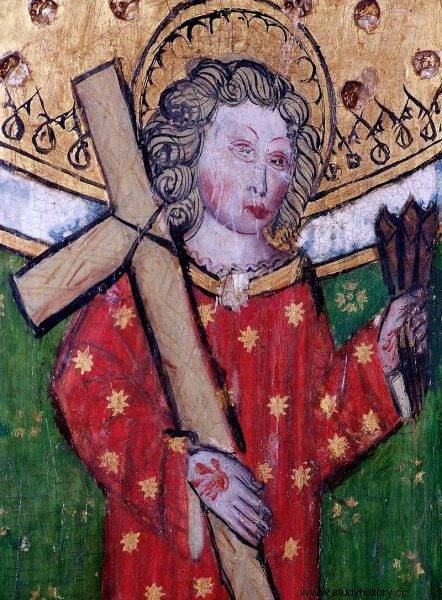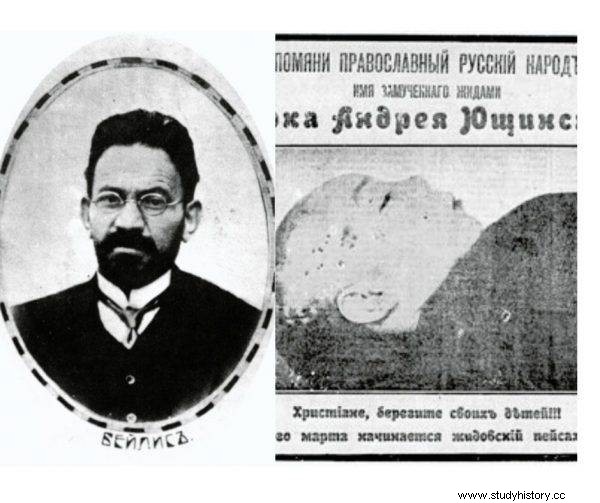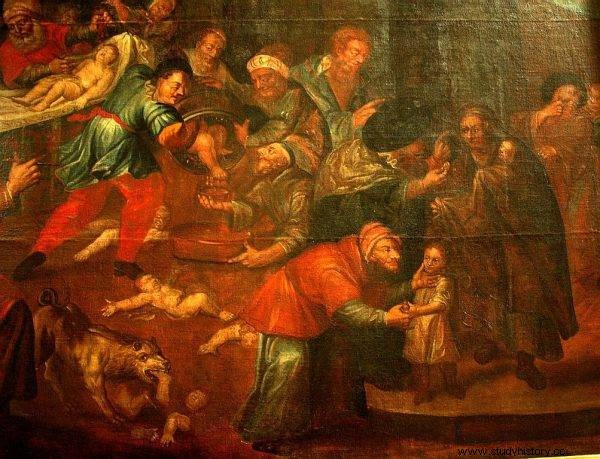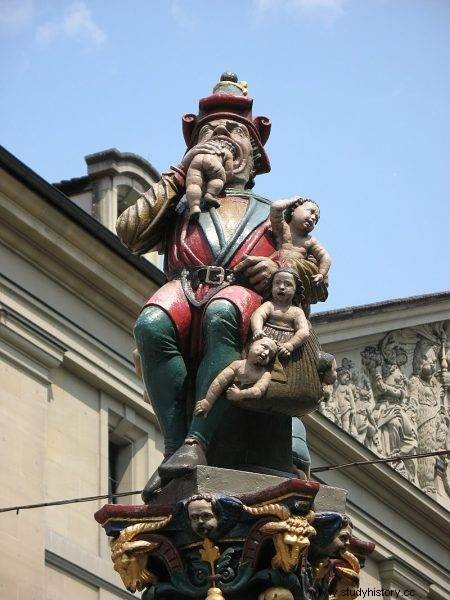A macabre crime shakes the town upside down. An inspector from Berlin selects the accused. But the local population has their own suspicions. Who could have committed a horror crime? Prejudice dictated by anti-Semitism makes even the strongest evidence irrelevant. There can only be one guilty party ...
Konitz (today Chojnice), West Prussia, March 11, 1900. Eighteen-year-old high school student Ernst Winter, after finishing lunch, leaves the Hermann Lange baker's house at Danzigerstrasse 26 (today Kościuszki 26), where he rented a room while studying. From that moment on, he was not heard of.
Corpse in the lake
Information about Winter's disappearance reaches his home town of Prechlau (today Przechlewo). The worried father goes to Chojnice, where he asks the mayor Georg Deditius for help from the police. The latter, however, refused. The desperate parent and his friend, the baker Lange, started a search on their own, which ended the following afternoon on the shores of the Teutonic Lake that does not exist today.
From its cloudy, partially icy waters, men fished a package wrapped in paper and string. After opening it, their eyes saw a picture like a horror movie - the upper part of the male torso devoid of arms and head . In this gruesome find, Johannes Winter recognized the body of his son. Shortly after, a second package was spotted, containing the missing legless part of the torso.

Tales of alleged ritual murders committed by Jews appeared as early as the Middle Ages. The first victim was to be twelve-year-old William of Norwich, murdered in 1144 in England. The story of the "holy youngster of Norwich" started a wave of reports of ritual murders all over Europe (source:public domain).
After the initial examination of the body, Dr. Mueller, who was called to the scene, noticed the precision of the cuts, indicating the exceptional skill of the torturer. He states that the act must have been done by a surgeon or a butcher . The city was overflowing with guesses not only about the guilty party of a monstrous crime, but also about the places where the remaining, still undiscovered parts of the body could be located. Some of them were found in the following days.
First, behind the gate of the (no longer existing) Protestant cemetery, in the fresh snow the children found their left arm . The left thigh was fished from the same Lake where the first parts of the body were found. The right arm was found using hunting dogs. Then (though many months later), at the edge of the forest, a head wrapped in a scarf, next to which a handkerchief with the "A" monogram was reportedly found.
"Kosher cuts"
The macabre of murder was shocking and spreading more and more echo. The guilty parties were very quickly and no less traditionally identified among the Jews who were to need blood for baking matzo . This version of events was sent to the minister of the province by the district official, baron von Zedlitz. He supported Dr. Mueller's more detailed research on the still incomplete corpse, after which he concluded that the death was due to a slit throat and a blood deflation.

Another famous trial of a Jew accused of ritual murder, already in the 20th century, was the so-called "Beilis case" that took place in Russia in 1913. Left:Menachem Mendel Bejlis. Right:his alleged victim, 13-year-old Andrij Juszczyński
This made a wide group of people interested in the events, even wrote about it in Berlin newspapers and it was from Berlin that a specially appointed commission came to conduct the investigation, which included, among others, the capital inspector of the homicide department named Braun.
He directed his suspicions on a Christian butcher - Gustaw Hoffmann . He was supposed to find out about Ernst's affair with his daughter Anna (who had been seen many times before in the company of the deceased), catch the couple in love and kill the teenager in emotion. In addition, there were witnesses who heard Hoffmann threatening Winter in the street . The new suspect countered the allegations by blaming the Jewish butcher Moritz Levi, which Gustaw motivated by recognizing "kosher cuts" on the corpse.
False witness
Hoffmann, despite his arrest, was quickly released from custody. There were at least two reasons for this. He was an important person in the city with many acquaintances - he held the position of a city councilor and master of the butchers' guild. Additionally, another councilor, Paul Bruhn, brought the police a certain Masloff, who was supposed to witness the events in Lewy's basement.
He testified that, while passing by his house, he noticed a light in the basement, and when he looked in it he noticed Jews dismembering the corpse who after some time took them packed towards the nearby Teutonic Lake.
This version smelled like a lie per kilometer and it quickly turned out that it was in fact completely made up. Witnesses who passed by in that area at that time saw neither the light in the basement nor Masloff. By himself, to see the whole event, he would have to spend a good hour lying on the ground on a cold March night.
Masloff, saving himself from the question of why he had not reported what he supposedly had seen earlier, claimed that he was going to Lewa's house to steal meat, hence he was afraid to bring the information to the police. A search of the basement did not reveal any clues supporting this theory, and Lewy himself had a very strong alibi.
Masloff's mother-in-law named Ross also attested to Moritz's guilt. She worked in Lewy's house and claimed to have seen Winter's cigarette case with his picture there. Soon it turned out to be a lie, and in the course of the investigation it turned out that the woman had plotted the whole plot herself, involving her son-in-law in it.

The painting Ritual murder depicting the alleged ritual murder from the cathedral in Sandomierz by Karol de Prevot (18th century)
The reason for their behavior was the reward , which was appointed by the Minister of Justice in return for indicating the guilty party - twenty thousand marks, the highest in German history at that time. It stimulated the human imagination and on this wave they decided to earn some extra money.
Instead of money, they both ended up on sentences, Ross - eighteen months in prison, Masloff - twelve months in prison. The court also asked for a pardon against the woman, but Emperor William II rejected her.
Need a scapegoat
Despite the dismissal of the testimony of these two witnesses and the lack of any evidence, as well as despite a strong alibi, the case against Lewa continued. The city council seemed to be doing everything possible to make him a scapegoat . Another argument for the ritual murder was the aforementioned opinion of Dr. Mueller, according to which Ernst was killed by slitting his throat and draining blood.
This version was strongly contradicted by studies carried out by the Department of Health of West Prussia in Gdańsk, and these findings were confirmed by the state health department. Both institutions indicated that Winter was strangled and then dismembered.
Therefore, everything seemed to be in favor of Lewy, but the court was afraid to acquit him because of the accusations of covering up Jewish murderers and the public mood. And these were, to put it mildly, tense. The Jews faced ever more frequent and brutal persecution - windows of their houses were broken, and they were caught in the streets.

Kindlifesserbrunnen sculpture.
Anti-Semitic moods were additionally fueled by the press which notoriously published articles blaming the Jewish community. A certain G.A. Dewald from Berlin even issued a postcard showing the moment of the murder, but was sentenced to six months in prison for it.
The climax came after Ernst Winter's funeral on May 27, which was attended by crowds. On June 8, an attempt was made to burn down the local synagogue and in the face of the failure of this action it was simply demolished.
The riots intensified to such an extent that they completely escaped the control of the local authorities, and even spread to nearby towns. Their scale was so large that, on the orders of William II, the army set out to suppress them.
Justice was done?
Therefore, although Moritz Lewy was acquitted of the murder charges, he was sentenced to four years in prison for making false statements . During the trial, he allegedly did not know Winter, but witnesses were found who denied this because they had seen the men talking to each other in the street. Moritz lied out of fear, yet was treated much more severely than the lying for Ross and Masloff's profit.
It is true that after two years of imprisonment, he was pardoned by the emperor, but at that time his family moved to Berlin, and the business and property in Chojnice fell into complete ruin. Moreover, in reaction to such open discrimination and fear for their own safety, over 150 Jews left the city .
A breakthrough in the investigation turned out to be the discovery of a garment belonging to Ernst Winter - a bloody jacket in the city forest, and trousers with traces of semen in the garden of the Masonic Lodge . On their basis and after careful analysis, the aforementioned commission from Berlin, led by Dr. Puppe, concluded that a high school student had been strangled in his clothes during sexual intercourse and then dismembered.

One of the inspirations for the text was the anti-Semitic booklet by Max Liebermann von Sonnenberg entitled Der Blutmord in Konitz from 1901 (source:public domain).
After gathering all this information, the case ... was closed due to the public mood. The murderer has never been identified and punished . Was it Gustaw Hoffmann? Everything seems to speak for it - he had a motive, he had opportunities, his alibi had been refuted. So why wasn't he convicted? Did his social position and anti-Semitic paranoia prevent him from being punished?
Attempts to return to the investigation were made by Braun himself in 1907, as well as by the Nazis during the occupation. Nevertheless, the matter remained unresolved. Sex, bestial murder, Jews, Masonic Lodge, riots, mysterious closure of the case before its resolution ... a ready-made film script, a story too interesting to be taught in schools.
